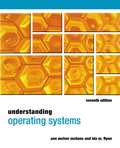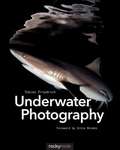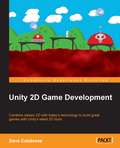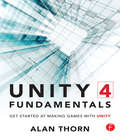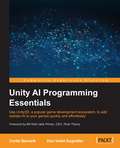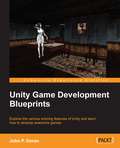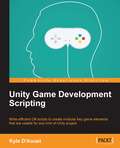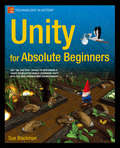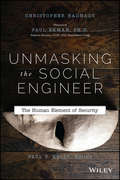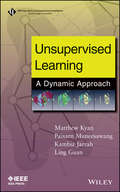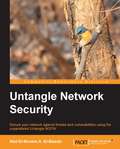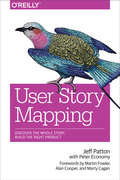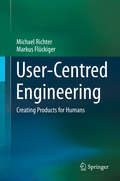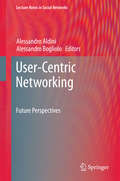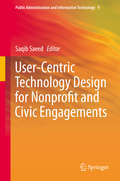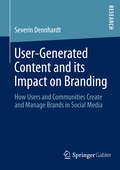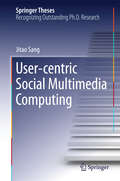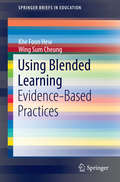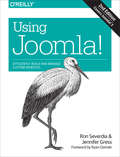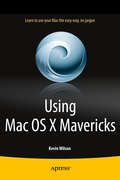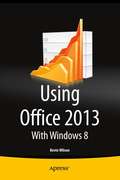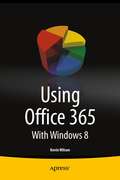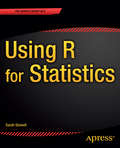- Table View
- List View
Understanding Operating Systems
by Ida M. Flynn Ann Mciver MchoesNow in its Seventh Edition, UNDERSTANDING OPERATING SYSTEMS continues to provide a clear and straightforward explanation of operating system theory and practice. As in previous editions, the book's highly regarded structure begins with a discussion of fundamentals before moving on to specific operating systems. Fully updated, this new edition includes expanded analysis of the impact on operating systems of such innovations as multi-core processing and wireless technologies. Revised Research Topics in the exercise section encourage independent student research. The final four chapters have been updated to include information on current versions of UNIX (including the latest Macintosh OS), Linux, and Windows, and a new chapter on Android has been added.
Underwater Photography
by Tobias FriedrichUnderwater photography is a fascinating pursuit for those who aspire to capture the magical world found within our oceans and bring it to the surface. In this book, award-winning photographer Tobias Friedrich teaches us how to create stunning underwater images, covering everything from the equipment needed, to creating powerful compositions, to processing the final image. He uses case studies to show how his own images were created, and provides detailed explanations for specific techniques that can be applied to your very next dive.The text is supported by images from some of the most beautiful diving areas on Earth. Also included are countless tips and tricks for the beginner and intermediate photographer.Topics include:Choosing the right equipmentComposing your imagesWide-angle photographyMacro photographyImage editingCase studiesDiagrams of shooting positionsAn added bonus is the 22-page Guest Gallery featuring images by some of today's most recognized names in underwater photography, including Ernie Brooks, Alex Mustard, Richard Salas, Imran Ahmad, and Eric Cheng.The abundance of breathtaking underwater images contained in this book is sure to inspire you to plan your next dive.Foreword by Ernie Brooks.
Unity 2D Game Development
by Dave CalabreseA fun, easy-to-follow experience that takes you from an empty project in Unity 4.3+ all the way to a finished, functional 2D platformer, while giving you challenges and ideas to take what you learn in this book and expand upon it. This book is ideal for anyone who wants to learn how to build 2D video games or who just wants to expand their knowledge of the Unity game engine. It would be helpful to know how to navigate your way around Unity and some basic C# before getting started with this book; however, if you don't, no worries - we will point you in the right direction!
Unity 4 Fundamentals: Get Started at Making Games with Unity
by Alan ThornGet ahead of the game with Unity 4. The Unity engine is the tool of choice for many indie and AAA game developers. Unity 4 Fundamentals gives readers a head start on the road to game development by offering beginners a comprehensive, step by step introduction to the latest Unity 4 engine. The author takes a theory-to-practice approach to demonstrate what Unity 4 has to offer which includes: Asset management tools Real-time lighting and lightmapping Particle systems Navigation and pathfinding
Unity AI Programming Essentials
by Dan Violet Sagmiller Curtis BennettThis book is aimed at developers who know the basics of game development with Unity and want to learn how to add AI to their games. You do not need any previous AI knowledge; this book will explain all the essential AI concepts and show you how to add and use them in your games.
Unity Game Development Blueprints
by John P. DoranIf you want to build enticing projects with Unity, this book is for you. Readers who are familiar with the basics of how to create simple projects in Unity will have an easier time.
Unity Game Development Scripting
by Kyle D'AoustIf you are new to Unity scripting and want to learn simple and modular code and advance your knowledge to the next level, this is the book for you.
Unity for Absolute Beginners
by Sue BlackmanUnity for Absolute Beginners walks you through the fundamentals of creating a small third-person shooter game with Unity. Using the free version of Unity to begin your game development career, you'll learn how to import, evaluate and manage your game resources to create awesome third-person shooters. This book assumes that you have little or no experience with game development, scripting, or 3D assets, and that you're eager to start creating games as quickly as possible, while learning Unity in a fun and interactive environment. With Unity for Absolute Beginners you'll become familiar with the Unity editor, key concepts and functionality. You'll learn how to import, evaluate and manage resources. You'll explore C# scripting in Unity, and learn how to use the Unity API. Using the provided art assets, you will learn the fundamentals of good game design and iterative refinement as you take your game from a simple prototype to a quirky, but challenging variation of the ever-popular first-person shooter. As can be expected, there will be plenty of destruction, special effects and mayhem along the way. Unity for Absolute Beginners assumes that you have little or no experience with game development, scripting, or 3D assets, but are eager to get up-to-speed as quickly as possible while learning Unity in a fun and interactive environment. What you'll learnHow to use the Unity editor, including key concepts and functionalityHow to use import, evaluate and manage resources for use in your Unity gamesHow to use the Unity API and script in Unity using C#The fundamentals of good game design and the process you need to use to make good gamesWho this book is for This book assumes that you have little or no experience with game development, scripting, or 3D assets, but are eager to get up to speed as quickly as possible while learning Unity in a fun and interactive environment. Table of Contents1. The Unity Editor2. Unity Basics3. Navigation and Physics4. Importing Static Assets5. Scripting with C#6. Mecanim and Animation7. Populating the Game Environment8. Weaponry and Special Effects9. Incorporating Unity 2D10. Menus and Levels11. Bonus FeaturesAppendix: Rigging with Mixamo"
Unmasking the Social Engineer
by Christopher Hadnagy Dr Paul EkmanLearn to identify the social engineer by non-verbal behavior Unmasking the Social Engineer: The Human Element of Security focuses on combining the science of understanding non-verbal communications with the knowledge of how social engineers, scam artists and con men use these skills to build feelings of trust and rapport in their targets. The author helps readers understand how to identify and detect social engineers and scammers by analyzing their non-verbal behavior. Unmasking the Social Engineer shows how attacks work, explains nonverbal communications, and demonstrates with visuals the connection of non-verbal behavior to social engineering and scamming. Clearly combines both the practical and technical aspects of social engineering security Reveals the various dirty tricks that scammers use Pinpoints what to look for on the nonverbal side to detect the social engineer Sharing proven scientific methodology for reading, understanding, and deciphering non-verbal communications, Unmasking the Social Engineer arms readers with the knowledge needed to help protect their organizations.
Unsupervised Learning: A Dynamic Approach (IEEE Press Series on Computational Intelligence)
by Matthew Kyan Kambiz Jarrah Ling Guan Paisarn MuneesawangA new approach to unsupervised learning Evolving technologies have brought about an explosion of information in recent years, but the question of how such information might be effectively harvested, archived, and analyzed remains a monumental challenge—for the processing of such information is often fraught with the need for conceptual interpretation: a relatively simple task for humans, yet an arduous one for computers. Inspired by the relative success of existing popular research on self-organizing neural networks for data clustering and feature extraction, Unsupervised Learning: A Dynamic Approach presents information within the family of generative, self-organizing maps, such as the self-organizing tree map (SOTM) and the more advanced self-organizing hierarchical variance map (SOHVM). It covers a series of pertinent, real-world applications with regard to the processing of multimedia data—from its role in generic image processing techniques, such as the automated modeling and removal of impulse noise in digital images, to problems in digital asset management and its various roles in feature extraction, visual enhancement, segmentation, and analysis of microbiological image data. Self-organization concepts and applications discussed include: Distance metrics for unsupervised clustering Synaptic self-amplification and competition Image retrieval Impulse noise removal Microbiological image analysis Unsupervised Learning: A Dynamic Approach introduces a new family of unsupervised algorithms that have a basis in self-organization, making it an invaluable resource for researchers, engineers, and scientists who want to create systems that effectively model oppressive volumes of data with little or no user intervention.
Untangle Network Security
by Abd El-Monem El-BawabIf you are a security engineer or a system administrator and want to secure your server infrastructure with the feature-rich Untangle, this book is for you. For individuals who want to start their career in the network security field, this book would serve as a perfect companion to learn the basics of network security and how to implement it using Untangle NGFW.
Urban and Rural Decay Photography: How to Capture the Beauty in the Blight
by J. Dennis ThomasIf you are a photographer who sees the beauty in abandoned buildings, crumbling facades, and preserving a fading history, and who also has a love of urban exploration, you have stumbled on a must-have for your photographic library. Urban and Rural Decay Photography offers expert tips and techniques for capturing breathtaking photographs of your favorite decay scenes, whether in urban or rural settings. Author J. Dennis Thomas guides you through the history of decay photography, shows you what equipment you will need, and discusses digital, film and HDR capture and composition. The book addresses which artistic considerations work best for the kinds of shots that capture a moment and convey a story. He also provides you with important safety advice and matters of the law when entering and working with decaying structures. Chock full of inspiring images that will ignite your creativity and your passion for decay photography, Urban and Rural Decay Photography is just the book you need to get you out and discovering your newest urban or rural exploration adventure.
User Story Mapping: Discover the Whole Story, Build the Right Product
by Peter Economy Jeff PattonUser story mapping is a valuable tool for software development, once you understand why and how to use it. This insightful book examines how this often misunderstood technique can help your team stay focused on users and their needs without getting lost in the enthusiasm for individual product features.Author Jeff Patton shows you how changeable story maps enable your team to hold better conversations about the project throughout the development process. Your team will learn to come away with a shared understanding of what you’re attempting to build and why.Get a high-level view of story mapping, with an exercise to learn key concepts quicklyUnderstand how stories really work, and how they come to life in Agile and Lean projectsDive into a story’s lifecycle, starting with opportunities and moving deeper into discoveryPrepare your stories, pay attention while they’re built, and learn from those you convert to working software
User-Centred Engineering
by Michael Richter Markus FlückigerA new product can be easy or difficult to use, it can be efficient or cumbersome, engaging or dispiriting, it can support the way we work and think - or not. What options are available for systematically addressing such parameters and provide users with an appropriate functionality, usability and experience? In the last decades, several fields have evolved that encompass a user-centred approach to create better products for the people who use them. This book provides a comprehensible introduction to the subject. It is aimed first and foremost at people involved in software and product development - product managers, project managers, consultants and analysts, who face the major challenge of developing highly useful and usable products. Topics include: The most important user-centred techniques and their alignment in the development process Planning examples of user-centred activities for projects User-oriented approaches for organisations Real-life case studies Checklists, tips and a lot of background information provide help for practitioners
User-Centric Networking
by Alessandro Aldini Alessandro BoglioloThis work represents a milestone for the "ULOOP User-centric Wireless Local Loop" project funded by the EU IST Seventh Framework Programme. ULOOP is focused on the robust, secure, and autonomic deployment of user-centric wireless networks. Contributions by ULOOP partners as well as invited tutorials by international experts in the field. The expected impact is to increase awareness to user-centric networking in terms, e. g. , of business opportunities and quality of experience, and to present adequate technology to sustain the growth of user-friendly wireless architectures. Throughout the last 3 years, ULOOP has developed enabling technologies for user-centricity in wireless networks, with particular emphasis on social trust management, cooperation incentives, community building, mobility estimation, and resource management. This work will be of interest to researchers, policymakers, operators, vendors, and end-users interested in the current and future directions of user-centric access networks.
User-Centric Technology Design for Nonprofit and Civic Engagements
by Saqib SaeedDue to the increased global political importance of the nonprofit sector, its technological support and organizational characteristics have become important fields of research. In order to conduct effective work, nonprofits need to communicate and coordinate effectively. However, such settings are generally characterized by a lack of resources, an absence of formal hierarchical structures and differences in languages and culture among the activists. Modern technologies could help nonprofit networks in improving their working. In order to design appropriate technological support for such settings, it is important to understand their work practices, which widely differ from traditional business organizations. This book aims to strengthen the body of knowledge by providing user studies and concepts related to user centered technology design process for nonprofit settings. The examination of ethnographic studies and user centered evaluation of IT artifacts in practice will further the understanding of design requirements of these systems. This book includes chapters from leading scholars and practitioners on the technology design process examining human centered factors. The chapters will focus on developed and developing countries as they both have unique issues in technology design. The book will be useful or of interest to academics from a range of fields including information systems, human computer interaction, computer supported cooperative work and organizational science as well as for government officials and governmental organizations.
User-Generated Content and its Impact on Branding
by Severin DennhardtThe emergence of social media as one of the driving forces of consumers' online experiences today also challenges our current understanding on marketing and brand management. The effects of brands' social media involvement are to this day uncertain. Severin Dennhardt shows that social media and user-generated brands do have a strong influence on brands. Four independent studies demonstrate that first, successful brands can be created in virtual worlds, second, user-generated content drives the creation of unique brands, third social media strongly influences the social value perception of brands, and fourth, social media impacts consumers' purchase decision process.
User-centric Social Multimedia Computing
by Jitao SangThis book presents the first paradigm of social multimedia computing completely from the user perspective. Different from traditional multimedia and web multimedia computing which are content-centric, social multimedia computing rises under the participatory Web2. 0 and is essentially user-centric. The goal of this book is to emphasize the user factor in facilitating effective solutions towards both multimedia content analysis, user modeling and customized user services. Advanced topics like cross-network social multimedia computing are also introduced as extensions and potential directions along this research line.
Using Blended Learning
by Khe Foon Hew Wing Sum CheungThis book discusses evidence-based practices related to the use of blended learning in both K-12 and higher education settings. Specifically, this book features evidence-based practices in relation to the following five learning goals: (a) Fostering students' attitude change toward country, (b) Helping students' solve ill-structured design task problems, (c) Improving students' critical thinking in assessing sources of information, (d) Improving students' narrative and argumentative writing abilities and (e) Enhancing students' knowledge retention and understanding. To achieve this aim, the authors draw upon their own research studies as well as some other relevant studies to reveal the pedagogical approaches, the specific instructional/learning activities, the technologies utilized and the overall framework for developing blended learning experiences.
Using Joomla!: Efficiently Build and Manage Custom Websites
by Ron Severdia Jennifer GressIf you’re new to content management systems—or even new to building websites—this practical guide will get you up and running in no time. You don’t have to know much code, if any, to get started.Need to build a website quickly? Have a client that requires a powerful website with lots of compelling features? Ideal for web designers and developers alike, this updated edition takes you step-by-step through site creation with Joomla, with plenty of hands-on exercises along the way.Build a sample site throughout the book to see how Joomla! worksPlan and structure your site’s categories, articles, menus, and modulesLearn the ins and outs of creating, organizing, and displaying contentAdd images, audio, and video—and create complete image galleriesBuild a blog, set up an events calendar, and create custom user formsSell merchandise by putting together your own online storeEngage visitors by creating user profiles and hangoutsSecure your site and keep it optimizedMigrate to Joomla! 3 and update your third-party extensions
Using Mac OS X Mavericks
by Kevin WilsonLearn to use your Mac the easy way: no jargon, just clear, concise and to the point. Using Mac OS Mavericks is your handy guide to using a computer running Mavericks, providing a quick resource for both the beginner and the enthusiast. Using Mac OS Mavericks is your handy guide to using a computer running Mavericks, providing a quick resource for both the beginner and the enthusiast. Step-by-step techniques supported by photography and screen prints, and easy to follow text, make using a Mac a cinch. Whether you have just bought your first Mac, switched from Windows, or are a keen computer user, this lean reference will provide you with the underpinnings needed to use a Mac like a pro. What you'll learn Valuable new features in Mavericks Setting up your Mac and using the interface, finders, dashboards and widgets Security and back-up considerations Setting up Wifi, Internet, and email, and using Mac App Store, iCloud and spotlight Creating stunning presentations and writing beautiful looking documents Organizing your favorite music into playlists, onto your iPod or burning a CD Creating, organizing, and storing photo albums and slideshows Editing your home movies with iMovie Who this book is for This book is for those who are new to Mac OS X Mavericks and even to those who may be new to Mac OS altogether. Table of Contents 1. Introducing Mavericks 2. The Cloud 3. Mac App Store 4. Time Machine 5. Security 6. Using the Internet 7. Apple E-Mail 8. Calendar 9. Using iTunes 10. iPhoto 11. Using iMovie 12. Pages '09 13. Keynote 14. Giving Presentations
Using Microsoft Office 2013
by Kevin WilsonLearn Office the easy way, no jargon. Clear, concise and to the point. . . Using Microsoft Office 2013, is the essential step by step guide to getting the most out of Microsoft Office, providing a complete resource for both the beginner and the enthusiast. This book explores constructing professional looking documents adding and using graphics and clipart, fonts, tables, graphs and formatting; creating stunning PowerPoint presentations for your lessons, lectures, speeches or business presentations powerpoint animations and effects setting up your projector and laptop ready to present. Using Excel to create spreadsheets to analyse data. Excel functions and formulas Excel charts and graphs and more. . . Techniques are illustrated in full colour step-by-step using photography and screen prints throughout, together with concise, easy to follow text from an established expert in the field, provide a comprehensive guide to office applications. Whether you are new to Microsoft Office, an experienced user or studying a computer skills course this book will provide you with a firm grasp of the underpinning foundations and equip you with the skills needed to use Office like a pro.
Using Office 365
by Kevin WilsonLearn Office the easy way, no jargon. Clear, concise and to the point. . . Using Microsoft Office 365, is the essential step by step guide to getting the most out of the traditional Microsoft Office applications (not SharePoint), providing a complete resource for both the beginner and the enthusiast. Techniques are illustrated step-by-step using photography and screen prints throughout, together with concise, easy to follow text from an established expert in the field, provide a comprehensive guide to office applications. Whether you are new to Microsoft Office, an experienced user or studying a computer skills course this book will provide you with a firm grasp of the underpinning foundations and equip you with the skills needed to use Office like a pro. What you'll learn How to use the new Microsoft Office 365 What is Skydrive and how to use it How to use the new Microsoft Word 2013 as part of Office 365 How to give presentations and use the Powerpoint 2013 as part of Office 365 How to do spreadsheets with Excel 2013 as part of Office 365 Who this book is for This book is for those new to Office 365 as well as those who are new to Office in general. Table of Contents 1. Microsoft Office 365 2. Microsoft Skydrive 3. Microsoft Word 2013 4. PowerPoint 2013 5. Giving Presentations 6. Microsoft Excel 2013
Using R for Statistics
by Sarah StowellUsing R for Statistics will get you the answers to most of the problems you are likely to encounter when using a variety of statistics. This book is a problem-solution primer for using R to set up your data, pose your problems and get answers using a wide array of statistical tests. The book walks you through R basics and how to use R to accomplish a wide variety statistical operations. You'll be able to navigate the R system, enter and import data, manipulate datasets, calculate summary statistics, create statistical plots and customize their appearance, perform hypothesis tests such as the t-tests and analyses of variance, and build regression models. Examples are built around actual datasets to simulate real-world solutions, and programming basics are explained to assist those who do not have a development background. After reading and using this guide, you'll be comfortable using and applying R to your specific statistical analyses or hypothesis tests. No prior knowledge of R or of programming is assumed, though you should have some experience with statistics. What you'll learn How to apply statistical concepts using R and some R programming How to work with data files, prepare and manipulate data, and combine and restructure datasets How to summarize continuous and categorical variables What is a probability distribution How to create and customize plots How to do hypothesis testing How to build and use regression and linear models Who this book is for No prior knowledge of R or of programming is assumed, making this book ideal if you are more accustomed to using point-and-click style statistical packages. You should have some prior experience with statistics, however. Table of Contents 1. R Fundamentals 2. Working with Data Files 3. Preparing and Manipulating Data 4. Combining and Restructuring Data Sets 5. Continuous Variables 6. Tabular Data 7. Probability Distribution 8. Creating Plots 9. Customizing Plots 10. Hypothesis Tests 11. Regression and Linear Models 12. Appendix A: Basic Programming with R 13. Appendix B: Add-on Packages 14: Appendix C: Data Sets
Using SPSS for Windows and Macintosh: Analyzing and Understanding Data
by Neil Salkind Samuel GreenThe development of easy-to-use statistical software like SPSS has changed the way statistics is being taught and learned. Even with these advancements, however, students sometimes still find statistics a tough nut to crack. Using SPSS for Windows and Macintosh, 7/e, guides students through basic SPSS techniques using step-by-step descriptions and explaining in detail how to avoid common pitfalls in the study of statistics.
